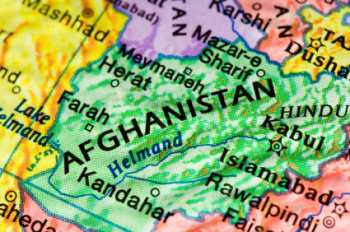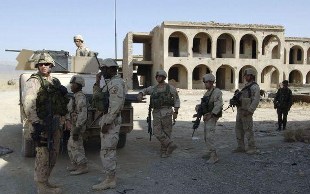When NATO began its invasion of the Marjah farming region, the general consensus among analysts was that the offensive, the single largest operation since the 2001 invasion of Afghanistan against a relatively anonymous little town in the middle of nowhere, was mostly a “PR” invasion to sell the continued to an increasingly skeptical Western public.
 But it is increasingly clear that wasn’t the whole story. Officials are now making it very plain that the invasion of Marjah was a “test” of a new strategy, that will be put into practice on a much larger scale with the invasion of Kandahar.
But it is increasingly clear that wasn’t the whole story. Officials are now making it very plain that the invasion of Marjah was a “test” of a new strategy, that will be put into practice on a much larger scale with the invasion of Kandahar.
The Marjah invasion was far from the runaway success officials promised, but it appears to have been “good enough” from their perspective, and it seems that it will be used more or less unchanged in Kandahar. But the lacking strategy will run into more problems than just transitioning from the invasion of a farming region of 80,000 to a city of nearly a million people.
The Marjah invasion saw around 15,000 troops invade and enormous influx of police aimed at “holding” the region. It also drove around a third of the population into refugee camps around Lashkar Gah. But it was invading a region that was more or less a blank slate, having never had a NATO military presence nor a presence of the Karzai government.
Kandahar, on the other hand, has been the center of a lot of violence since the NATO invasion, and has been torn by numerous corruption scandals surrounding the Karzai government’s police, and Karzai’s brother Wali. Kandahar’s residents will be under no illusions that the offensive will solve its serious corruption problems.
 In contrast to Marjah, which was mostly built up in the 1960s by American investors to showcase modern agricultural techniques, Kandahar has enormous historical and cultural significance to the Taliban. It was the site where Mullah Omar founded the movement, and will probably see much more fierce resistance.
In contrast to Marjah, which was mostly built up in the 1960s by American investors to showcase modern agricultural techniques, Kandahar has enormous historical and cultural significance to the Taliban. It was the site where Mullah Omar founded the movement, and will probably see much more fierce resistance.
It is unclear when the offensive will start, but amassing tens of thousands of troops for a push into the city will likely take months, putting the attack likely in late spring to early summer. This will give the Taliban plenty of time to prepare, even more than they had in Marjah, and will likely create a much larger refugee problem as one of the nation’s largest cities is transformed into a battlefield.





I'm not sure what they think they are achieving. If anything, Afghanistan is an example of the failure of US foreign intervention. In fact, the more they try to intervene, the more they seem to hurt their own interests.
http://www.watchinghistory.com/2010/02/us-interve…
I'm not sure what they think they are achieving. If anything, Afghanistan is an example of the failure of US foreign intervention. In fact, the more they try to intervene, the more they seem to hurt their own interests.
http://www.watchinghistory.com/2010/02/us-interve…
it would be very comical if not for the innocent people being killed
to think of the worlds strongest country in the world going to literally the furtherest place from our borders on the planets an killing a bunch of peasants who may go back generation with out ever even seeing an ocean
Perhaps you've read about the 11 Afghans killed when their farm vehicle triggered an IED or the four who died at the hands of a suicide bomber in Kandahar? Is that OK since it wasn't the U.S. that killed them? The Taliban continues to put many thousands of innocent lives at risk and have terrorized their own. Does anyone really think this will change if and when NATO leaves?
There are signs of life now in Marjah. Obviously, Kandahar is an entirely different challenge but one that I think the good people of Afghanistan are ready for. Are they not now living in fear of the Taliban?
NATO was designed as a defensive alliance against potential Soviet aggression in Europe, not to "change the lives" of people in Afghanistan.
US planned War In Afghanistan Long Before September 11
http://www.wsws.org/articles/2001/nov2001/afgh-n2…
Insider accounts published in the British, French and Indian media have revealed that US officials threatened war against Afghanistan during the summer of 2001. These reports include the prediction, made in July, that "if the military action went ahead, it would take place before the snows started falling in Afghanistan, by the middle of October at the latest." The Bush administration began its bombing strikes on the hapless, poverty-stricken country October 7, and ground attacks by US Special Forces began October 19.
It is not an accident that these revelations have appeared overseas, rather than in the US. The ruling classes in these countries have their own economic and political interests to look after, which do not coincide, and in some cases directly clash, with the drive by the American ruling elite to seize control of oil-rich territory in Central Asia.
The American media has conducted a systematic cover-up of the real economic and strategic interests that underlie the war against Afghanistan, in order to sustain the pretense that the war emerged overnight, full-blown, in response to the terrorist attacks of September 11.
We Do Not Have Clean Hands In Afghanistan
http://www.rense.com/general68/hands.htm
A scant percentage of Americans know that ten days before President Kennedy was assassinated, he made a speech at Columbia University, during which he made the following statement: "The high office of the President has been used to foment a plot to destroy the American's freedom and before I leave office, I must inform the citizen of this plight."
John Fitzgerald Kennedy (May 29, 1917 – November 22, 1963)
I have given a lot of thought to those words, his assassination, and what he was prevented from saying to America.
One of the things most noticeable to me since 1963 is how the Office of the President of the United States has been used to create and push bogus policy on bogus facts. History has shown that the Gulf of Tonkin incident that escalated the Vietnam War was staged by the United States. I have repeatedly seen this nation invent enemies or even arm enemies to create a war in the future for massive defense spending initiatives. I have also seen them implement policies based on lies just so the wealthy elite can make a lot of money, stained with the blood of dead American soldiers. Yes, they also use policy by gunpoint to steal what belongs to others and then hold themselves up high as Great Americans when they are mere thieves.
Undercounting Deaths of US Soldiers in Iraq and Afghanistan
http://globalresearch.ca/index.php?context=va&…
Contractor deaths are rarely reported!
By most counts, the death toll of U.S. soldiers in America's wars in Iraq and Afghanistan stood at 5,157 in the second week of September. Add at least 1,360 private contractors working for the U.S. and the number tops 6,500.
Contractor deaths and injuries (around 30,000 so far) are rarely reported but they highlight the United States' steadily growing dependence on private enterprise.
It's a dependence some say has slid into incurable addiction. Contractor ranks in Iraq and Afghanistan have swollen to just under a quarter million. They outnumber U.S. troops in Afghanistan and they almost match uniformed soldiers in Iraq.
The present ratio of about one contractor for every uniformed member of the U.S. armed forces is more than double that of every other major conflict in American history, according to the Congressional Budget Office.
Afghanistan after the Russians
http://www.socialismtoday.org/61/repreint.html
MUCH TO THE surprise of Western capitalist governments, all Russian forces will be withdrawn from Afghanistan before 15 February. Gorbachev’s eagerness to meet the agreed deadline, however, is as one-sided as last year’s Geneva Accords. Under this UN-sponsored agreement between the USSR, the US, and Pakistan, both sides agreed to cease ‘interference’ and to phase out military support for the contending forces in Afghanistan. Although the Soviet Union has meticulously stuck to the letter of the pact, neither the US (through the CIA), nor Pakistan has ceased to finance and arm the mujaheddin.
As it became clear that the Russian forces would actually be out by the deadline, the Western powers, led by the US and fervently supported by Thatcher, have stepped up their efforts to destabilise the regime of president Najibullah. The withdrawal of all Western diplomatic missions, for example, was obviously a calculated attempt to help precipitate the collapse of the Kabul regime.
Obama Losing To China & Russia In Afghanistan
http://www.realzionistnews.com/?p=447
That looks like a NAZI website.
Nato with major US troops take Kandahar down in 3 weeks. The Marines will devour the city. You can count on this